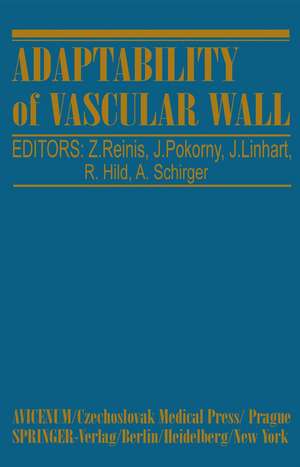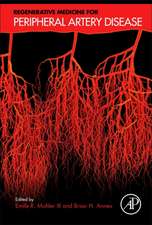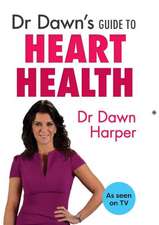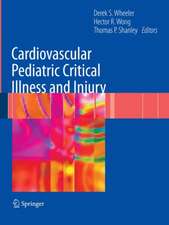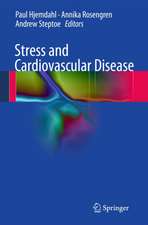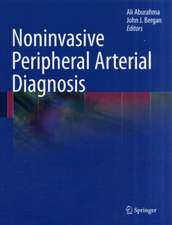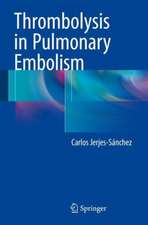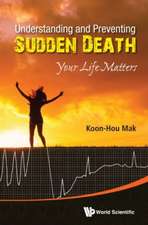Adaptability of Vascular Wall: Proceedings of the XIth International Congress of Angiology-Prague 1978
Editat de Z. Reini;&AKs;, J. Pokorn;&AAy;, J. Linhart, R. Hild, A. Schirgeren Limba Engleză Paperback – 26 iul 1980
Preț: 395.25 lei
Preț vechi: 416.05 lei
-5% Nou
Puncte Express: 593
Preț estimativ în valută:
75.65€ • 82.21$ • 63.59£
75.65€ • 82.21$ • 63.59£
Carte tipărită la comandă
Livrare economică 21 aprilie-05 mai
Preluare comenzi: 021 569.72.76
Specificații
ISBN-13: 9783540099079
ISBN-10: 3540099077
Pagini: 780
Ilustrații: XX, 756 p. 153 illus.
Dimensiuni: 155 x 235 x 41 mm
Greutate: 1.08 kg
Editura: Springer Berlin, Heidelberg
Colecția Springer
Locul publicării:Berlin, Heidelberg, Germany
ISBN-10: 3540099077
Pagini: 780
Ilustrații: XX, 756 p. 153 illus.
Dimensiuni: 155 x 235 x 41 mm
Greutate: 1.08 kg
Editura: Springer Berlin, Heidelberg
Colecția Springer
Locul publicării:Berlin, Heidelberg, Germany
Public țintă
ResearchDescriere
The International Congresses of Angiology have had a 25-year tradition. Let us remember the 10 previous International Congresses, the first of which took place in Paris in 1952. On this occasion a stimulus for the foundation of the International Union, "Union Internationale d Angeiologie" came into existence. The period of 25 years is lon.qenough to evaluate the scientific progress which has been made in diagnosis, therapy and prevention of vascular diseases. Proceedings of the previous International Congresses of Angiology became attractive resources for scientific information in libraries all over the world. They represent really historic documents of remarkable development of angiology and wittness successful international cooperation in the settlement of serious medical problems of the twentieth century. The Proceedings of the XI. International Congress of Angiology held in Prague 1978 under the stimulating title "Adaptability of Vascular Wall" contains 284 original papers dealing with scientific and clinical research in arterial, venous and lymphatic circulation. The papers are incorporated into 12 chapters according to the main topics. In the first sections the questions of atherogenesis and thrombogenesis are discussed with regard to the adaptability of vascular wall in various metabolic, immunobiologic, and hemodynamic disorders. In the further sections attention is paid to new procedures in investigation, treatment, and prevention of arterial, venous, and lymphatic diseases. Peri pheral microangiopathies, renovascular hypertension, and coronary circulation represent another part.
Cuprins
Atherogenesis.- Physiological, morphological and angiochemical changes in aorta and lower extremity arteries in macaca fascicularis monkeys fed an atherogenic diet for 3 years.- The proliferative activity of aortic endothelium and its significance for atherogenesis.- Ultrastructural aspects of atherogenesis.- Atherosclerosis of the coronary artery in normolipemic swine induced by withdrawal of hypervitaminosis D3.- The effect of different cholesterol diets on the localisation of sudanophilic lesions in rabbits.- Localization of some peptidases in the vascular wall.- Spontaneous calcifying medial sclerosis of rabbits.- Experimental pathological study on arterial wall injury given by elevated intravascular pressure and its repair-blood pressure and circumferential tension.- Effects of certain drugs on experimental atherosclerosis in swine.- Regression of atherosclerosis: The cellular response and the local action of HDL.- Drugs affecting arterial permeability and atherogenesis.- Experimental atherosclerosis: Survival and spontaneous regression.- Regression of experimental atherosclerosis.- The reversibility of the human atherosclerotic plaque.- Electron microscopy remarks on the possibility of regression of human atherosclerosis.- Serum lipids and vasomotoric response of rats during experimental atherosclerosis.- Diffusible cholesterol and atherogenesis.- Studies on vessel wall cells of normal, hypertensive and streptozotocin diabetic animals. I. The proliferative capacity.- II. Biomethematical evaluation of the proliferative capacity.- Molecular distribution of plasma triglyceride in arterial occlusive disease.- Lecithin cholesterol acyltransferase (LCAT) in prognosis of cardiovascular complications.- The effect of Chelaton III on calcium metabolism in the arterial wall.- Aortic changes in spontaneously hypertensive rat (SHR) as related to atherogenesis.- Round-table discussion.- Thrombogenesis.- The effect of a new inhibitor of platelet aggregation (K 3920) on some platelet functions in patients with vascular diseases.- Pathogenetic role of humoral agents released by platelet aggregation in the genesis of transient ischemic attacks.- Platelet hypoaggregability in spontaneously hypertensive rats related to thrombogenesis.- Platelet adhesion, on the involvement of glycocalicin, an easily soluble platelet membrane glycoprotein in the interaction between platelets and the factor VIII-related protein.- Platelet regeneration time in cardiovascular patients.- Atherosclerosis and factor XIII. A new technique for the determination of factor XIII using a laser nephelometer.- Fibrinolytic activity of the arterial wall of patent and occluded arteries.- Fibrinolytic activity in hyperlipoproteinemias.- Interaction of angiography with the blood coagulation and the fibrinolytic system.- Soluble fibrin in plasma and endoperoxide-formation in platelets as an indication of prethrombotic states following myocardial infarction.- Erythrocyte membranes as a target for antithrombotic agents.- Different forms of soluble fibrin monomer complex indicating their different developmental processes in hypercoagulable states.- Vascular operations with the aid of an autotransfusion system: Changes in blood coagulation.- Thrombogenic and atherogenic influence of castration in women.- Metabolism of Vascular Wall.- Serum lipoprotein abnormalities in early stages of peripheral atherosclerosis.- Hyperlipoproteinemia and peripheral arterial disease.- Serum lipoprotein distribution in 103 nonagenarians.- Arterio-venous differences of various plasma proteins in peripheral vascular disease.- A study of low and very low density lipoproteins penetration, a racioactive label in the core of the lipoprotein particle, into the arterial wall.- Protein components of edema fluid and serum.- DNA template activity of aortic wall cells in experimental diabetes.- Stiffness of the arterial wall in response to potassium and pharmacological activation.- Prostaglandin-like activity in patients suffering from occlusive arterial diseases.- Prostaglandins and motility of human veins.- A rational basis for the use of drugs with endotheloprotective activity in peripheral ischaemia.- Biomechanical properties of hog carotid arteries.- Biomechanical properties of normal and fibrosclerotic human internal carotid arteries.- Biomechanical and histological research on healthy and varicose human veins.- The influence of cigarette smoking on human arterial explants in vitro.- Postischemic hyperresponsiveness of canine carotid arteries.- Volume and surface areas of some vascular smooth muscle cell organelles in rat.- Flow-resistance relationship for the cerebrovascular system of rabbits under normal and pathophysiological conditions.- Cell-kinetical investigations in the peripheral arterial vessels of rats with depot-angiotensin-hypertension between 3 hours and 14 days.- The reactivity of isolated venous preparation from rabbits pretreated with reserpine.- Effects of oxygen, hypoxia, metabolic inhibitors, nitrite, indomethacin, and adenosine on the spontaneous tone of a nerve-free vessel, the human umbilical artery.- Neurovascular transmission related to the rate and number of stimulation impulses.- Immunological Aspects of Vascular Diseases.- Immunological studies in chronic occlusive arterial diseases.- Significance of immunological studies of peripheral arterial diseases.- Vascular changes of low calcium diet fed animals against soluble immune complex.- Blood serum proteins and free SH groups in the diagnosis of classical polyarteritis nodosa.- The effect of autologous serum and some drugs on cellular immune reactions in vascular diseases.- Immunology of endothelial cells action of ticlopidine.- Immunological and functional of results allogeneic vein transplantation in the low pressure system.- Immunological and functional results of allogeneic vein transplantation within the arterial system.- Adaptability of Vascular Tissue Surgery.- Reconstruction or amputation in old people with aortoiliac occlusive arterial disease?.- Results of reconstructive surgery for occlusive disease of aortoiliac and femoropopliteal arteries.- The healing of vascular prostheses in a man.- Secondary reconstructive operations in patients after aortoiliac surgery.- Thrombosis of aorto-iliac reconstruction: Origin, prevention and treatment.- Long-term changes of calf blood flow and local pressure in patients with aortofemoral reconstruction.- Results of femoropopliteal venous bypass operation in chronic arterial occlusion.- Our experience with the in- situ bypass in chronic occlusive disease of the femoropopliteal artery.- Reconstructive surgery in ischemic diseases of lower limbs.- Indications and results of the direct surgical treatment of chronic arterial occlucive diseases.- Causes of failure after reconstructive arterial operation in patients with chronic ischemic disease of the legs.- Our experience with femoro-femoral cross-over.- Revascularization of the profunda femoris artery-long term results.- Femorotibial bypass: an 8-Years experience.- Reconstruction of the popliteal and crural arteries based on our own material.- Long term results of surgical treatment in Buerger’s disease.- The treatment of chronic arterial occlusion of the upper-and lower- leg bloodflow with a femoro-popliteal and femoro-crural by-pass. — Indications, short — and longterm results.- Management of thoracic outlet compression syndrome.- Indications of reconstructive surgery in angina abdominalis.- Surgery of the intestinal arteries.- Clinical and experimental results of the surgery of the extracranial cerebral vessels.- Lumbar sympathectomy as an alternative treatment of occlusive arteriosclerotic diseases of the low extremities.- Experimental and clinical embolization of the spleen.- Surgical treatment of thinking and coiling of the internal crotid artery.- Experimental A — V fistula: Dilatation of muscular type artery at elevated flow rates.- Value of revascularization operations on the bifurcation of the common carotid artery in patients with chronic stroke.- Venous homograft in advanced arteritis of the legs. Report of 30 cases.- The effect of blood flow on vein grafts in the arterial bed.- Does the grafted femoral vein “arterialize”?.- Ultrastructural investigations of experimental venous grafts.- Role of chemical modification of surface properties on the long — term patency of vascular prostheses.- Adaptive changes in the internal diameter of the carotid artery to prolonged shear stress load and its relationship to the optimality principle of the vascular tree.- Use of the umbilical cord for reconstructive vascular surgery.- Long-term results following replacement of the femoral artery by preserved DLA-compatible fetal aortal grafts in dogs.- Hyperstomy syndrome of the legs, long term result of surgical treatment.- Epidemiology and Prevention of Vascular Diseases.- Medical care for patients with vascular diseases (Individual and social problems).- Arterial occlusive disease with hypertension as a possible risk factor?.- Professional risk faktors in arterial occlusive disease.- The value of rescreening of some risk factors with respect to the importance of intervention.- Epidemiology of peripheral vascular disease by the Doppler ultrasonic technique.- Five years incidence of arterial occlusive disease in north czech men.- Epidemiology and natural course of atherosclerotic ischaemia of lower limbs.- A longitudinal study of arterial blood pressure with regard to primary prevention of ischaemic heart disease.- Prediction of the risk of stroke myocardial infarction in patients with manifest arteriosclerosis.- Multifactorial prevention of coronary heart disease in the male industrial population.- Multifactorial primary prevention study on myocardial infarction and stroke.- The need for primary prevention of atherosclerosis in childhood.- Smoking — an important risk factor in arterial occlusive disease.- Asymptomatic ischemic heart disease in an industrial plant.- Investigation of Arterial and Venous Disorders.- Are exercise tests useful tools in the functional evaluation of peripheral ischemia?.- Continuous treadmill walking test in evaluation of muscular performance of ischemic lower extremities.- The treadmill test in chronic arteriopatic subjects.- Hemodynamic and metabolic changes in the lower extremities during ergo- metric exercise and glucose infusion.- Foot blood flow during reactive hyperemia in patients with ischemic disease of the lower extremities.- Strain gage venous occlusion plethysmography, technical possibilities and clinical experiences.- Evaluation for partial proximal reconstruction in patients with severe ischemia of the foot.- Third order waves of plethysmogram (T. O. W.) and the differentiation of arteriosclerosis obliterans from thromboangiitis obliterans.- A study of the influence of acupuncture on digital blood flow using the strain gauge plethysmography technique.- Venous occlusion plethysmography experiments concerning the “Borrowing-lending-phenomenon” under the influence of pentoxifyllin and naftidrcfuryl.- Experience with transvenous xeroarteriography in vascular surgery.- Contribution to the assessement of lymphedema by xeroradiography.- Thermo-diagnosis of circulatory changes after artificially created arterio-venous shunt for haemodialysis of patients with chronic renal insufficiency.- Comparative value of Doppler ultrasound and segmental plethysmography in the diagnosis of arterial diseases in the lower limbs.- Comparative rating of three methods (Doppler ultrasound, XE-133 clearance, rheography) for the measurement of perfusion pressure and flow in the lower extremities of vascular patients in Fontaine II.- Doppler sonography of femoro-popliteal reconstruction.- Recording the post-exercise femoral velocity using a Doppler-velocimeter.- Ultrasonic duplex echo-Doppler arteriography in diagnostics of arterial diseases.- Arterial non-invasive methods of investigation in comparison with arteriography.- The reactive hyperemia test on a lower limb for assessing an aorto-iliac obstruction by the Doppler effect.- Radiocirculographic measurement of blood flow in occlusive arterial disease of the lower extremities.- Phlebography and pressure measuments in the postthrombotic state (a comparative study).- Sequential scintigraphy of the aorta and the arteries of the extremities.- Influence of elevated artery pressure on alteration of arterial collaterals in angiograms.- The significance of extensive angiographic studies of patients with Klippel-Trenaunay syndrome.- Evaluation of isotope angiography in vascular surgery.- Arterial insufficiency of the hand evaluated by digital blood pressure and artetiographic findings.- The comparison of the diagnostic value in the detection of the causative lesions of cerebrovascular insufficiency among aortic arch study, carotid and vertebrobasilar arteriograms.- Hemodynamic assessment of common femoral endarterectomy and profundaplasty.- Hemodynamics in the cold pressor test.- Thermography in conjunction with stellate ganglion block in the diagnostic investigation of vascular disorders of the upper extremities.- Electrophysiological examination of ischaemic diseases of the lower limbs.- The use of polarography in vascular diseases.- Arterial and venous blood viscosity in ischemic lower limbs of peripheral obliterative arterial disease patients.- Changes in pH, pO2, and pCO2 in the venous blood of patients suffering from obliterative arteriosclerosis of the lower extremities.- Arteriography and digital plethysmography in the study of diabetic macroartericpathy of the feet.- The objective assessment of venous insufficiency with calf volume plethysmography.- Investigations of peripheral arterial blood flow by measuring the minimal transit time of a radioactive tracer.- Round table discussion.- Peripheral Microangiopathies.- Dynamic methods for the clinical investigation of microcirculation.- Synthesis and migration of proteins in juxtaglomerular cells. An ultrastructural radioautographic study.- Red cell aging as model influencing pharmacologically red cell deformability.- Diabetic microangiopathy.- Problems of microangiopathy, capillary filtration and neurocirculatory changes in potential and manifested diabetes mellitus.- Muscular biopsy in diabetic microangiopathy.- Reactive hyperemia under plethysmography control in the early diagnosis of diabetes.- Capillary functions in vascular diseases.- About the diabetic microangiopathy and macroangiopathy.- Experimental investigations into the ‘risk factor”-smoking with special emphasis on platelet function and blood rheology.- Vascular disorder caused by vibrating tools.- Digital circulation in cases with Raynaud’s phenomenon and treatment with Hydergin.- Genetic factors in Takayasu’s disease.- Increased vascular permeability in developing collateral pathways of rabbits after femoral artery ligation.- Vascular reactivity in skin and muscle after myocardial infarction.- Action of piracetam on serum induced spasms in pial arterioles of rabbits.- Do the differences in angio-architecture between normotensive (NR) and spontaneously hypertensive rats (SHR) influence the arterio-venous PO2 balance?.- Critical lesions of cervical arteries induce retinal A — V anastomoses in cases of occlusive thromboaortopathy (Takayasu’s disease).- Microcirculation and oxygen utilization in skeletal muscles of spontaneously hypertensive rats (SHR).- Histomorphometric studies at the microcirculatory bed in spontaneously hypertensive rats (SHR).- Induction mechanisms of metastatic hepatic cancers viewed from blood vessel constructions and their histomorphological forms.- Venous and Lymphatic Circulation.- The influence of drugs on human venous tone.- Development and structure of the venous wall.- The “risk factors” of phlebothrombosis and thromboplebitis.- Chronic venous insufficiency following surgery on the inferior vena cava and the large veins.- Incidence of calf vein thrombosis after extracorporeal circulation.- Thrombosis of femoral and iliac artery after catheterisation.- About reactivity changes in organism in case of thrombotic diseases in the veins of lower extremities.- New aspects of post-thrombophlebitic syndrome.- Little tricks of the trade in the surgery of varicose veins.- A time-saving and successfull technique of varicose vein operation.- Complete reconstruction of the subclavian vein occluded at the costoclavicular level.- Surgical management of varices of short saphenous vein as indicated by two-directional phlebography.- Current aspects on the management of secondary sapheno-femoral valvular incompetence.- New operating methods of surgical healing of varices in lower extremities, accordirg to Luža.- Practical aspects in the differential diagnosis of lyphedema of the extremities.- Isotope lymphographic examinations for the critical appraisal of functional condition of lymphatic flow.- Lymphoscintigraphy in the study of lymphatic circulation.- Cardiac lymph in ventricular fibrillation: An experimental study.- Lymphovenous anastomoses of the heart.- Vascular tumors of the extremities.- Lymphangiography in moderate disturbances of lymphodynamics in the lower limbs.- Long term results of medical and surgical treatment of lymphedemas of legs.- Pharmacology and Therapy of Vascular Diseases.- Effects of various drugs on experimental and clinical atherosclerosis.- Pharmacological control of aortic enzymes involved in atherogenesis.- Physiological and electronmicroscopical observations in experimental ischemic heart disease.- Protective action against cerebral ischemia by a new imidazole derivative (Y-9179) and pentobarbital: A comparative study of chronic middle cerebral artery occlusion in cats.- The effect of Ca++ antagonists on the limb blood flow.- Ca-antagonist drugs for the study and treatment of angiospastic syndromes.- Clinical experience with prostaglandin E1 in severe peripheral artery disease.- The present status of vasodilator therapy. An analysis of underlying mechanisms.- Clinical experience with Pyridinol carbamate.- The effect of nitroglycerine in acral pulse curve and acral circulation in the upper limb.- Veinous-occlusion-plethysmographic examination on the behaviour of resting-blood-flow and reactive hyperemia during intra-veinous long-term-therapy with vasoactive drugs.- Ergotism — a severe complication during treatment of headache.- Continuous intraarterial infusion-therapy of prostaglandin E 1 for ischemic ulceration of the extremity.- Adaption of arterial wall to physical stress before and after pentoxifylline administration.- Effect Bencyclane, Pentoxifylline and Vincamine on cerebral vascular resistance in rabbits.- Double-blind trial with Benzyclane in patients with peripheral arterial disease.- Significance of anthocyanins in the treatment of peripheral vascular diseases.- An approach to the individualization of phenprocoumon therapy.- Control of therapy in patients with chronic ischemic disease of the extremities by measuring the local oxygen pressure.- Study on long-term treatment with anticoagulants of atherosclerosis obliterans.- Treatment for lymphedema of the extremities.- Aspirin in the prophylaxis of arteriovascular diseases in cardiac infarction.- Anticoagulant prophylaxis and thrombolytic therapy for thromboembolic complications of angiography.- Intra-arterial infusion of middle doses of urokinase in obliterative atherosclerosis of the lower limbs.- Experience with urokinase in older phlebothrombosis.- Experimental homocysteinemia and thromboembolism action of ticlopidine.- Dehydroepiandrosterone- a new coronary pain relieving factor. In vitro and in vivo reduction of oxygen consumption.- Clinical antihypertensive activity of ISF 2123.- The influence of L-ascorbic acid on hyperlipemia in maturity-onset diabetes mellitus.- Multicenter trial with Tiadenol in primary hyperlipidemias.- Modern drug treatment of hypercholesterolemia.- The present position of Clofibrate.- Beta blockers and lipid metabolism.- Blood viscosity in primary hyperlipoproteinemia under hypolipidemic therapy.- The effect of Trimepranol on Serotonin release and thrombocyte aggregation in the rat.- Antihypertensive action of Trimepranol and Trimepranol combined with Saltucin.- Hyperlipemic effect of beta-blocking agents in experimental atherosclerosis.- Metipranolol and several other beta-blocking agents: A comparative pharmacological study.- Pindolol: A pharmacokinetic comparison with other beta-andrenoceptor blocking agents.- The antihypertensive and antiarrhytmic effect of Pindolol.- Antihypertensive effect of Pindolol (Visken) and a combination of Pindolol and Clopamide (Brinaldix) in moderate hypertension.- Does beta blockade affect blood flow to the limbs?.- Pharmacology and pharmakokinetics of Trimepranol (Symposium).- Experimental pharmacology.- Effects on cardiac function in dog.- Pharmacokinetics and effects on heart action in man.- Clinical experiences.- Renovascular Hypertension.- Renal arterial fibrodysplasia and spectrum of the structural changes of human ischaemic kidney.- Angiographic findings in hypertension.- Diurnal rhythm of electrolyte excretion and surgical management of renovascular hypertension.- Renovascular hypertension in Takayasu’s arteritis.- Thermal diagnosis of peripheral vascular resistance in arterial and especially renovascular hypertension.- Experience in ex-situ repair of renal artery stenosis.- Our opinion on disputable problems of vasorenal hypertension treatment.- Surgical correction of malignant hypertension by means of renal artery reconstruction.- Current status of surgical management of renovascular hypertension.- Venous allografts for arteriovenous fistulas in haemodialysis.- Coronary Circulation.- Anomalous coronary arteries.- Coronary circulation on the venous side in the human heart with the special references to the venae cordis minimae.- The index of permeability of coronary arteries to albumin.- Pathological changes of he small coronary arteries in postinfarction aneurysms.- Calcium activation processes in the smooth muscle of coronary arteries and their selective inhibition.- Coronary arteries and myocardial metabolism.- Identification and management of the candidate for sudden cardiac death.- Coronary heart disease in patients with peripheral arterial occlusion.- Changes in myocardial trace element level in experimental coronary occlusion and myocardial infarction.- Autonomic control of conduit coronary artery diameter.- Systolic time intervals under conditions of physical exercise in investigation of the 40–59 year old male population.- Angiocardiographic and echocardiography evaluation of left ventricular function.- A real-time echocardiography tracking system for anterior ventricular wall motion.- Echocardiography assessment of left ventricular performance in patients with arterial hypertension.- First pass nitro-glycerin RAO radionuclide angiography: noninvasive evaluation of myocardial viability.- Studies of vasoactive substances in isolated coronary arteries using a modified perfusion technique.- Free amino acids as indicators of acute myocardial ischaemia.- Ischaemic heart disease in young women and their ovarian function.- The influence of mechanical heart assist (MHA) upon some features of the myocardial metabolism in experimental infarction.- Assistant circulation with an intraaortal balloon pulsation (IABP) — system in myocardial infarction: changes in blood coagulation.- Interaction of venous endothelium and right ventricle endocardium to long-term cardiac pacing leads.- Videodensimetric measurement of phasic blood flow in aortocoronary bypass grafts.- Microcirculatory changes and early myocardial revascularization.- Role of nuclear cardiology in the present practice of coronary surgery.- Current status and prospects of coronary surgery.- Myocardial revascularization in marked left ventricular dysfunction.- Validity of aorto-coronary bypass surgery in impending myocardial infarction.- Round table discussion Reconstruction.- Round table discussion Counterpulsation.
